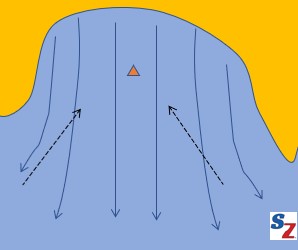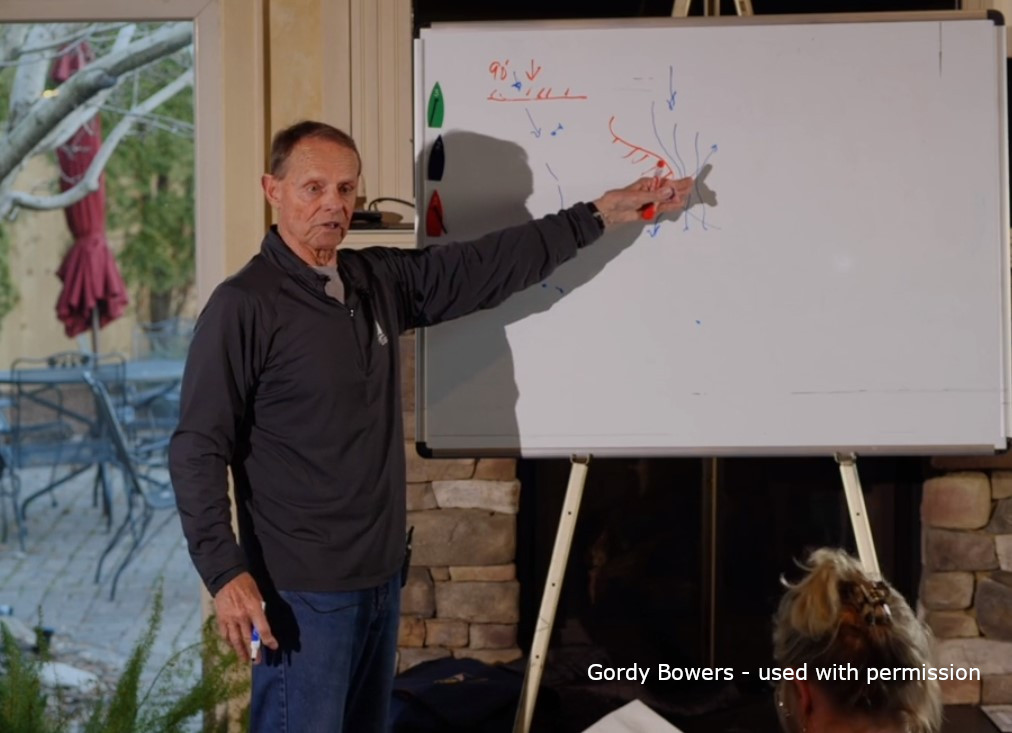We decided to tackle the topic of shore effects on lakes after seeing examples on Lake Okoboji and running across a great video from the Wayzata (MN) Yacht Club, featuring Gordy Bowers discussing the Winds of Minnetonka. As we’ll show, there is some predictability regarding shore effects on lakes, but there’s also a large component of chance.
Most experts shy away from discussing shore effects on lakes, especially small lakes, since there are so many variables. Winds of Minnetonka is most complete discussion we’ve seen. From 00:45:00 to 00:54:45 in the video, Gordy discusses six shore effect situations that can apply to lakes. We’ll summarize these briefly, but you should watch this section of the video to get Gordy’s commentary.
In the remainder of the video (00:57:10 to the end) Gordy discusses shore effects on Lake Minnetonka for eight different wind directions. This is definitely worth watching but is too long to summarize in this post. Instead, we’ll discuss three situations from the 2021 ILYA MC Scow championship at Lake Okoboji.
Six Shore Effects on Lakes
#1. Shifting Right (Veering) After Leaving a Windward Shore (00:45:00 in video)

Most sailing weather books tell you that the wind shifts to the right as it leaves shore. Shifting to the right is called veering, and it results from the combined effects of friction and the earth’s rotation. As the wind leaves the shore it speeds up, due to reduced friction. As it speeds up, it shifts right in the northern hemisphere due to the earth’s rotation. Here’s a nice video showing why hurricanes always spin counterclockwise in the northern hemisphere. This is the same reason the wind shifts right as it accelerates.
Gordy shows how you can use this to approach the mark near a windward shore. If the mark is close enough to the shore, make your final approach from the left to get the relatively left direction closer to the shore.
#2. Bending Around a Point of Land on Side of Course (00:46:20 in video)

If the wind is flowing along the shore and encounters a point of land, it will bend around the point. To take advantage of this, sail toward the apex of the point. You’ll get a lift just before you get to the apex, as the wind starts to bend around. Once you get to the apex, the lift will turn into a header; tack and you can sail away on a lift. Avoid getting into the wind shadow of the point.
#3. Tricky Shifts Around a Point of Land to Windward of Mark (00:47:20)

If the windward mark is downwind of a point of land, you could have real trouble getting to the mark. Depending on the phase of the wind – shifted right or shift left, one approach will be favored. This can change quickly and you have to look up the lake frequently to guess the correct side. One side may be more likely to pay based on the shorelines on either side of the point.
#4. Channeling Around a Bend (00:49:15)

In a relatively narrow section of lake, with the wind parallel to the shore, the wind tends to follow the direction of the channel. Similar to example 3, if the channel bends, you can approach the apex of the bend on a lift, tack when you reach it, and sail away on a lift.
#5. Spreading Out of a Bay (00:50:00)

With the windward mark just inside the mouth of a bay, the wind spreads out to the right and left as it exits the bay. First, decide which side has more wind. Then try to figure out where the bend occurs and sail to it, taking advantage of the lift as you approach the bend, then tacking where the bend occurs. Do the same thing downwind, gybing when you reach the bend.
#6. Convergence and Divergence – the Railroad (00:51:00)

We discussed convergence and divergence is our post Light Air on Lakes – More Wind Near the Shore? The left shore (looking upwind) may have stronger wind due to convergence. The wind leaving the left shore converges into the wind over the water and adds to it. The wind entering the right shore diverges (bends away from) the wind over the water and subtracts from it.
Gordy points out that convergence on the left shore also produces frequent left shifts. If you approach the left shore and tack at the proper distance, you can ride a “railroad” of lefties up the shore.
Cautions
If you don’t think theory is very useful when discussing shore effects on lakes, you’re not alone. A Sailing World article, Mysteries of the Shoreline Wind, points out the variety of expert opinions on how wind flows over a near-shore race course. The conclusion from that article states,
“So my view is do the observation and get the local knowledge. The best data will be venue- and wind-condition specific, and not based on any particular theory.”
Dr. Gavin Dagley in Sailing World.
In the Winds of Minnetonka video, Gordy gives us his take on the theory and the results of his years of observations, but he frequently couches his predictions in terms of probabilities. He also tells us to first observe what’s happening before relying on any local knowledge.
Shore Effects Examples – Lake Okoboji

At the 2021 Inland Lake Yachting Association Championships on Lake Okoboji, the MC Scow fleet sailed on several different courses. Here are three of the courses, two of which demonstrated shore effects. The average wind direction was similar for all three examples – in the range of 165 – 180 degrees.
- On course 1, the point of land to the left – about halfway up the course – demonstrated reliable apex behavior. The lift at the apex persisted long enough to gain an advantage.
- On course 2, there was a similar point of land to the left and a large bay to the left. The left side of this course did not reliably pay off. You couldn’t sail close-hauled off the line and get to the apex of the point. Also, the bay on the left was filled in on the first beat, but not on subsequent beats.
- On course 3, the left side at the top of the course was mostly reliable – say 80% of the time. This may have been due to convergence on the left shore.





